Thank you for returning to read my latest article. In this article I would like to talk about the lost art of the “deer drive”.
There are many people out there that discount this age old practice due to belief that it is unethical and unsportsmanlike to hunt deer or any big game in such a matter.
I think I have only seen it shown on TV hunting shows maybe once or twice ever, and I watch a lot of hunting shows.
Now to a person that did not grow up learning this style of hunting, I can see how this is true. Some people may not know how to accurately shoot at a running deer or lack the confidence to do so.
If a deer drive is not properly planned out with your hunting party, it can be very dangerous as well. But, if done safely, and properly, it is a very effective way to harvest deer.
I grew up and have lived my entire life in the state of Wisconsin. In the Midwest, the deer drive is a long standing deer camp tradition. It is however, in my opinion, being phased out by most people, preferring to emulate what they learn from watching TV and reading magazines, where such a thing is generally frowned upon. In the Midwest region of the country, until the past couple decades; deer hunting was a way to put food on the table. Hunters were not going out to specifically to harvest a trophy whitetail, although they all dreamed of doing so. Normally people would sit their stands the first day or so, but if no luck was to be had, well we made our own luck. We needed food in our freezer, and if that meant bumping that giant out of the area in hopes to put a tag on a doe for meat, well then so be it.
In my opinion, things have definitely changed.
Tip #1 Safety, Safety, Safety
Did I forget to mention safety? It is true that this can be a very dangerous tactic to use while trying to harvest deer. Always make sure everyone knows where they can and cannot safely shoot. Many hunters have paid with their lives shooting into areas where they are not supposed to during a deer drive. If there is no safe direction for walkers to shoot due to position of the standers, then the walkers should not carry their guns on the drive, to avoid temptation to shoot at a deer that may jump out of its hiding spot.
This was made clear to me on my first deer drive. I still remember like it was yesterday, my first ever deer drive. It was Thanksgiving Day in 1986. I had sat opening weekend seeing only a few deer. From what I can remember, no one had put a tag on a deer as of yet. After the Thanksgiving morning hunt we met at the trucks for lunch and started planning a drive. I was nervous, hoping I did would not screw up. Since I was using a 20 gauge shotgun, younger, and full of youthful energy, I was chosen to be one of the walkers. My father and older brothers, who had longer shooting rifles, were to be the standers. My other brother Tony was also chosen as a walker, because he also carried a shotgun. We chose to drive out a corn field that sat on the east end of the property. I was told sternly to follow the rules to ensure the utmost safety of everyone participating. My father and two other brothers would set up in the corners of the corn to catch deer that broke out of hiding. They were not allowed to shoot into the corn at all, for obvious reasons; my brother and I were in it! Tony and I were not allowed to shoot anywhere but straight down the rows of corn, this way we would not run the risk of shooting the standers stationed in the corners of the field.
We gave our predetermined signals to the standers that we were starting to walk into the field. Everyone was in place and ready for what was to come. As I took my first step into the rows, I grew ever more nervous. I was 12 years old and all of about 4 feet 8 inches tall. The corn we were walking into was over 7 feet tall! I could not see anything farther than 5 feet in front of me. All I knew was I had to walk straight through the corn and follow the rows so everyone knew where to expect me to be. I did not make it through the field 30 yards when I heard my brother Tony bellow “DEER!” and I heard shots start ringing out from his shotgun, or at least I thought it was him as I really could not see anything. I could hear corn stalks crashing all around me, and shots began to ring out from every perceivable direction. I pulled my gun up and knelt down in the middle of the corn, half expecting to get run over by a deer at any point in time. To say I was freaking out would be an understatement! For what seemed like 10 minutes, but was in reality probably only 30 seconds, the commotion subsided. My brother Tony started to yell my name to check to make sure I was safe. I did not immediately answer his calls because I was still in defense mode ready for a deer to plow through and run me over. After a few calls I finally answered him, “Ya!” They all started asking where I was. I could not answer them, as I was slightly disoriented, and my heart and brain was going at a million miles per hour. The only thing I could think of to do was put my blaze orange hat on the end of my barrel and raise it above the stalks of corn so they had a chance to see just where I was. They told me to make my way out. I gladly followed that piece of advice and walked until I reached the outskirts of the corn, leaving my hat on my gun barrel pointed above the corn the entire way, almost like a flag of surrender. As I reached the end of the corn I noticed my family standing around a doe that lay on the ground in front of them. They had taken, to the best of my childhood recollection, 3 does during that short drive. In a matter of a minute or so, my family had the much needed venison to sustain us through until the following deer season.
Tip #2 The Set-up
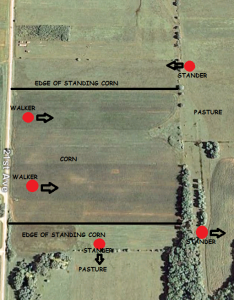 The position of the standers is paramount to the success of your drive. Standers should be set up to block all escape routes of the deer you are trying to move. I will use my hunting property to give you an example of this. The lay out of this land is simple. On the East side of the property is a large ridge with open mature hardwoods. The ridge only rises up about 10-15 feet in elevation. The West side of the land is a cow pasture that covers about 10 acres or so and runs adjacent to the road. The North end is a corn field, and the south end is a swampy area that the deer use as bedding and butts up to public land. The swampy area extends through the middle of the property essentially cutting it in half. This finger of swamp running between the hardwoods to the east and the pasture to the west makes for a perfect travel and escape route for the deer. Our walkers start by coming in on the public land to the south and push through the swamp towards the corn in the north. The deer normally follow the swamp on their way to the corn, essentially making it a pinch point. They do not like escaping through open territory, preferring to stay in cover as long as possible. We put one stander on the ridge to the east to catch any deer that shoot out the side, one in the pasture for the same reason, and then 1 or 2 along the corn to block off any way of escape. If there are any deer bedded down in the swamp, they are sure to bust out in the direction of one of the standers. The walkers in this scenario do not have much opportunity for shots due to the thickness of the cover, which is also why the deer love to hide here. If your standers have all escape routes blocked, success is assured. If there are any gaps or escape routes not covered, it is guaranteed the deer will find the weakness and exploit it.
The position of the standers is paramount to the success of your drive. Standers should be set up to block all escape routes of the deer you are trying to move. I will use my hunting property to give you an example of this. The lay out of this land is simple. On the East side of the property is a large ridge with open mature hardwoods. The ridge only rises up about 10-15 feet in elevation. The West side of the land is a cow pasture that covers about 10 acres or so and runs adjacent to the road. The North end is a corn field, and the south end is a swampy area that the deer use as bedding and butts up to public land. The swampy area extends through the middle of the property essentially cutting it in half. This finger of swamp running between the hardwoods to the east and the pasture to the west makes for a perfect travel and escape route for the deer. Our walkers start by coming in on the public land to the south and push through the swamp towards the corn in the north. The deer normally follow the swamp on their way to the corn, essentially making it a pinch point. They do not like escaping through open territory, preferring to stay in cover as long as possible. We put one stander on the ridge to the east to catch any deer that shoot out the side, one in the pasture for the same reason, and then 1 or 2 along the corn to block off any way of escape. If there are any deer bedded down in the swamp, they are sure to bust out in the direction of one of the standers. The walkers in this scenario do not have much opportunity for shots due to the thickness of the cover, which is also why the deer love to hide here. If your standers have all escape routes blocked, success is assured. If there are any gaps or escape routes not covered, it is guaranteed the deer will find the weakness and exploit it.
Tip #3 Play the Wind
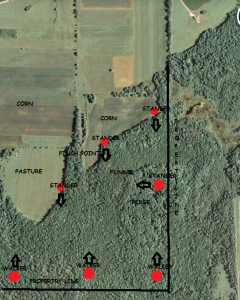 The wind is always a primary concern when it comes to hunting whitetails. The whitetail’s best defense is its sense of smell. While playing the wind during a deer drive, there are different factors to consider than just sitting in your stand. You should line up your walkers to walk with the wind, and your standers should be upwind of the drive. This allows the deer to smell the walkers. Letting the deer smell you may be something that goes against all you have been taught about hunting deer. The main purpose of letting the deer smell the walkers is to make them move before being jumped. If the deer sense your presence before you jump it they will move off towards the standers much sooner. If the deer do not know the walkers are coming towards them, you run the risk of jumping them at close range. If you startle the deer they are more likely to run full speed away. A deer at full speed is far harder to hit for the standers than one that is try to creep away. When they are moving away slower they are more likely to stop to look back at the danger, giving the shooter a chance to get a clean shot. A startled deer will not stop running until it knows it is safe. There are so many variables in taking a shot on a whitetail that is running for its life. You have to be able to hit something the size of a paper plate that is running at 30+ mph, and is bounding up and down, and zigzagging left and right. It almost seems impossible when you think about it. I have taken several deer while running, but have missed more. It is difficult to make an accurate shot at that target, and there is no way to practice for such a scenario. I have yet to see a rifle range that has moving targets that move as randomly as a running deer. There are some ranges that have a running deer moving target, but it is mainly a target that moves at a slower more predictable speed, and they move in straight lines. To make this shot requires either great skill or great luck, most of the time luck. With this in mind, I agree with most that say it is unethical for the majority of people to attempt this shot. The practice I have with this shot is the fact that I have made many of them. With deer drives firmly infused into my blood, I know what to expect when attempting a running shot. Opening day 6 years ago, I was sitting in my traditional rifle stand overlooking a corn field. Late in the morning a 7 point buck came out of the woods at full run across the cow pasture I was hunting over, headed for the corn. I knew if it hit the corn field it was going to be impossible to take it. I settled my rifle on a tree branch in front of me and started to track the deer through the iron sights of my Marlin 336 .35 Remington. This model gun is usually only good for shots under 200 yards; and that is in ideal shot conditions, but I knew my gun well.
The wind is always a primary concern when it comes to hunting whitetails. The whitetail’s best defense is its sense of smell. While playing the wind during a deer drive, there are different factors to consider than just sitting in your stand. You should line up your walkers to walk with the wind, and your standers should be upwind of the drive. This allows the deer to smell the walkers. Letting the deer smell you may be something that goes against all you have been taught about hunting deer. The main purpose of letting the deer smell the walkers is to make them move before being jumped. If the deer sense your presence before you jump it they will move off towards the standers much sooner. If the deer do not know the walkers are coming towards them, you run the risk of jumping them at close range. If you startle the deer they are more likely to run full speed away. A deer at full speed is far harder to hit for the standers than one that is try to creep away. When they are moving away slower they are more likely to stop to look back at the danger, giving the shooter a chance to get a clean shot. A startled deer will not stop running until it knows it is safe. There are so many variables in taking a shot on a whitetail that is running for its life. You have to be able to hit something the size of a paper plate that is running at 30+ mph, and is bounding up and down, and zigzagging left and right. It almost seems impossible when you think about it. I have taken several deer while running, but have missed more. It is difficult to make an accurate shot at that target, and there is no way to practice for such a scenario. I have yet to see a rifle range that has moving targets that move as randomly as a running deer. There are some ranges that have a running deer moving target, but it is mainly a target that moves at a slower more predictable speed, and they move in straight lines. To make this shot requires either great skill or great luck, most of the time luck. With this in mind, I agree with most that say it is unethical for the majority of people to attempt this shot. The practice I have with this shot is the fact that I have made many of them. With deer drives firmly infused into my blood, I know what to expect when attempting a running shot. Opening day 6 years ago, I was sitting in my traditional rifle stand overlooking a corn field. Late in the morning a 7 point buck came out of the woods at full run across the cow pasture I was hunting over, headed for the corn. I knew if it hit the corn field it was going to be impossible to take it. I settled my rifle on a tree branch in front of me and started to track the deer through the iron sights of my Marlin 336 .35 Remington. This model gun is usually only good for shots under 200 yards; and that is in ideal shot conditions, but I knew my gun well. 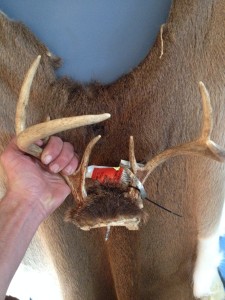 I knew the closest that deer was going to get was about 175 yards away and with it at a full run, most people would not even think of attempting it. As it got closer and closer to the corn I knew it was now or never. I concentrated on my aim, let out a deep breath, and touched off a round. The deer folded up where it was at. I would be foolish to think that a shot like that was all skill. I know for a fact that there was a lot of luck involved. If the deer would have varied any on its path to the corn, I would have missed badly, or worse, wounded the deer so it would suffer. I am confident in taking a running shot, but it is not for everyone. 99% of all shot opportunities on deer during a drive will be moving deer, anything you can do to make the deer take a slower retreat; will greatly improve your odds of success.
I knew the closest that deer was going to get was about 175 yards away and with it at a full run, most people would not even think of attempting it. As it got closer and closer to the corn I knew it was now or never. I concentrated on my aim, let out a deep breath, and touched off a round. The deer folded up where it was at. I would be foolish to think that a shot like that was all skill. I know for a fact that there was a lot of luck involved. If the deer would have varied any on its path to the corn, I would have missed badly, or worse, wounded the deer so it would suffer. I am confident in taking a running shot, but it is not for everyone. 99% of all shot opportunities on deer during a drive will be moving deer, anything you can do to make the deer take a slower retreat; will greatly improve your odds of success.
Tip #4 Make Noise
Make noise you say? Well that is another tip that goes against the grain of traditional thinking when it comes to whitetail hunting. There are multiple reasons for walkers to make noise while on a drive. First is for safety reasons. If the walkers are making noise, then the standers can more easily pinpoint the location of the walkers, insuring that the standers know not to fire at your location. It also gives them an educated guess as to how much farther the walkers have to go before the drive is complete. It also aids in letting the deer know the walkers are coming, giving them ample opportunity to move before being startled and jumped from their bed. Once again, a deer creeping away slowly in an attempt to be undetected is easier to shoot than a running deer. This tactic is especially effective when driving through corn fields. Deer tend to hang tight in corn and will not jump until the last second and can hide rather well between the rows. I have developed a fun and entertaining cadence when making noise through the corn. I like to talk a lot and loudly and I also try to smack corn stalks on my way through. I want them to move before I get to them.
Tip #5 Be Prepared
As a stander, never in any circumstances, relax while you are waiting for the walkers. Always have your weapon in hand and pay close attention to your surroundings. The action can happen at any time and from any direction. It can be all over in a matter of seconds. I have seen deer pushed from drives while the walkers are still hundreds of yards away, and I also have had deer come out after the drivers have passed by. As discussed before, the deer will more than likely be on the run when you see it. If you get nice and comfy and lean your weapon up against a tree next to you, it will take longer for you to set up a shot. If you have your gun already in your hand when the deer comes through, you can quickly pull up and take your shot. If you have to pick your gun up first, your opportunity might pass you by before you have a chance. Never get caught unprepared on a drive.
Even walkers on the drive need to pay close attention. If you are a walker that is allowed to shoot on the drive, your window of opportunity will be even shorter. Instead of moving towards you like the standers, the deer is moving away from you, and quickly! You may only have a second or two to try and pull off an ethical shot. If you do not have a shot, or are not carrying a weapon, you can try to signal the standers that you have a deer on its feet if you see a deer jump and start moving away.
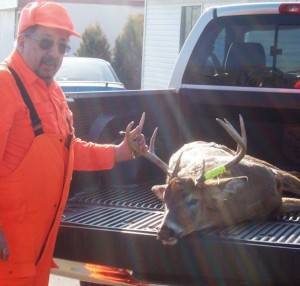 A few years ago, I was a walker on a short drive at our hunting property. I was equipped with a two-way radio to communicate with the standers, and I was the only walker. I made it about a quarter of the way through my drive when I jumped 2 does and a mature 9 point buck out of a thicket. Because I paid attention to my surroundings and never relaxed during my walk I was able to see the deer and tell the standers what was coming at them. My dad was ready with his gun up and into position already by the time that buck crested the ridge line in front of him. It was the biggest buck of his life, and undoubtedly noticing what was going on in front of me greatly helped in the success of that drive.
A few years ago, I was a walker on a short drive at our hunting property. I was equipped with a two-way radio to communicate with the standers, and I was the only walker. I made it about a quarter of the way through my drive when I jumped 2 does and a mature 9 point buck out of a thicket. Because I paid attention to my surroundings and never relaxed during my walk I was able to see the deer and tell the standers what was coming at them. My dad was ready with his gun up and into position already by the time that buck crested the ridge line in front of him. It was the biggest buck of his life, and undoubtedly noticing what was going on in front of me greatly helped in the success of that drive.
Tip #6 Lower Your Standards
While everyone would like to sit back and wait on that mature buck, it is very hard to age a deer while it is moving quickly through the woods. You may only have a couple of brief seconds to react and shoot at any given deer. You will never have the opportunity to study the deer and determine age. If you only want to shoot a buck that is 4 ½ years old or older, then deer drives may not be for you. While a small buck is fairly easy to judge while running quickly through the woods, you probably will not be able to tell the difference between 2 ½ year old and a 4 ½ year old. A running deer will appear more stretched out than a deer just standing there in a relaxed state, so you will not see if that deer has a large chest and pot belly as compared to a younger sleeker deer. And forget about trying to count points or judging score. If you try to judge the age and score of a deer before shooting, the deer will more than likely pass you by before you can figure it out.
Button bucks are another reason you may want to lower your expectations. If you are on a drive that permits you to take a doe, you run the risk of shooting buck fawns. While it is fairly easy to tell a fawn doe from a mature deer, it is not that easy with button bucks, especially in the north. By the time deer season rolls around in November, button bucks are normally the size of the adult does. Their body frame is larger than doe fawns, and can really fool you when on a full run. Even if the button buck is running next to a couple mature does, it does not look much smaller and can easily be thought to be a doe. If you do happen to shoot a buck fawn, do not get down on yourself about it. Take it from me, a professional chef, those fawns taste delicious! As I have always said, “Nothing tastes better than a baby vegetarian”.
Tip #7 Choose Your Weapons
The choice of weapons for your individual position in a deer drive is a critical factor. If you are a walker that is permitted to shoot, never carry a weapon with a scope. There are a couple reasons for this. As I mentioned before in this article, your window of opportunity will normally be shorter than that of a stander. To get a proper sight picture through your scope, it will take longer, running the possibility of missing your window. If you have a bead sight or iron sights on your gun you can more quickly acquire your target, improving your odds. I like to choose a shotgun for my weapon when I am a walker. My shots are usually close range and in dense cover. A high powered rifle bullet does not move through brush as easily as a shotgun slug. If I use a rifle, I use one without a scope and usually choose a slower moving bullet that will bust through brush without being deflected as much as a fast moving bullet. My rifle of choice is usually a lever action such as a 30-30 or my favorite, a .35 rem. Round nose bullets bust brush more easily than a pointed bullet, without as much deflection.
Walking through heavy brush where deer like to hide when pressured, can easily knock your scope off of zero, causing other headaches while deer hunting. If you knock off your zero, you will never know it, and this may cause you to miss your target or worse, wound the deer and cause it suffering.
Standers should be positioned in such a way that their gun matches the shot opportunities. If a stander has a short range rifle, then that shooter should be set up for short range shots. You do not want to set up a person with a short range rifle in a spot where his shot opportunities may be further than his guns effective range. If you have a spot in the drive where the stander has the chance to shoot out a couple hundred yards or so, you will want a long, flat shooting gun. On that same note, if the shot scenario will be something within 50 yards, you may want a shooter with a short range gun such as a shotgun or 30-30, rather than a 30-06 or 7mm-08. The cartridge you fire should always be considered when planning out your drive.
Tip #8 Driving Public Land
This is perhaps the most dangerous of situations. Public land is just that; public! Anyone, at any point in time, may wander onto the property. If you pull up to an empty parcel of land and decide you want to do a drive on it, make sure all safety rules are in place. You could all split up to your respective positions, and then another hunter could pull up, unaware of what is taking place. This puts both drivers and the other hunter in serious danger. If you believe the land is empty, but it suddenly is not, you may be shooting at a person you do not know is there. Alternatively, he might not know that there is a person walking towards him and take a shot at a deer you pushed, and put you or your standers in danger. If you choose to drive public lands, set up either a stander or walker where they can see if anyone else has entered the property, such as close to a road. This way if someone does enter the property, he can communicate to others and adjust your plan accordingly. A two-way radio helps in this so you can easily and instantly tell others, and everyone in your party is aware of what is going on.
I hope you find this article helpful when planning your next outing. While some may think this is an unethical or unsporting way of hunting, it is without doubt, an effective way to harvest deer. My party does several drives per year and has it down to a science, but the only thing we can predict, is the unpredictability of the whitetail deer.
If you follow some of these basic tactics; it will greatly increase your chances to put backstraps on the dinner table.
I would like to thank you all for taking the time to read this article. Good luck to all those venturing into the woods this fall and happy hunting!
Discover more from The HuntFishTravel Show
Subscribe to get the latest posts sent to your email.
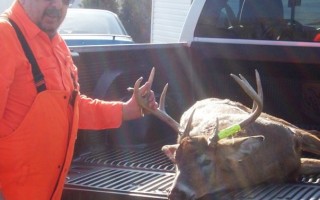



Nice writeup! So few people that engage in deer drives nowadays, and fewer that know and understand how to properly employ them.
We do lots of deer drives in the south, glad to see our northern brethren partake as well in this way of hunting.
Good write up.
Thank you! It is becoming a lost art now a days. To me and my hunting family it is the most exciting way to hunt
We love our deer drives in the great white north. The practice spans many generations up here. It is a fun way to hunt when done safely. Thanks for the comment!